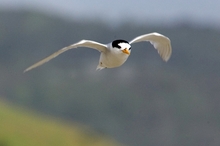NZ Herald Article
Thoughtlessness proves lethal to rare birds' coastal nesting spots By Susan Edmunds 5:30 AM Sunday Jan 12, 2014
Filename: Herald_article.oxps ( view )
Size: 295.8 KB
Document type: application/zip ( )

The nesting spots of fairy terns are also some of NZ's busiest holiday destinations. Photo / Paul Estcourt
Selfish or ignorant holidaymakers are threatening one of the world's most critically endangered birds by letting their dogs roam free within metres of nesting chicks.
Only 36 fairy terns are left, including 10 breeding pairs.
This summer, eight eggs didn't hatch, but 12 chicks have taken flight this month - the best result since tern conservation began 30 years ago.
Yet their nesting spots - at Waipu, Mangawhai, Pakiri and South Kaipara Head - are also some of New Zealand's busiest holiday destinations.
The population of Waipu doubles to more than 3,000 people at this time of year.
The beachgoers are flouting rules intended to ensure fairy tern chicks survive to leave their nests.
Locals say some visitors are unaware of the ban on dogs. Others don't care and become abusive, insisting they have a right to walk their dogs on the beach.
When the Herald on Sunday visited Waipu Cove this week, a corgi was running off-lead 200m from the area's one fairy tern nest.
The dog's owners, Aucklanders Blair Zhang and Kalvin Ng, had stopped for a picnic with family and said they did not know much about the terns - or any rules on where their dog was allowed.
They certainly had not intended to endanger wildlife. "I don't know whether we can bring dogs here or not," Zhang said.
The Department of Conservation last year successfully lobbied Whangarei District Council to ban dogs on the beach near the Waipu wildlife refuge, where Zhang and Ng were sitting.
The popular Waipu Cove campground, with up to 1,000 guests, is next to the refuge.
Its owners distribute information about the birds.
But New Zealand Fairy Tern Charitable Trust member Sandra Bogart said many people still ignored the rules.
She said if people or animals got too close to a tern nest, the birds would pretend to have a broken leg to try to lure them away, leaving their nest open to predators.
"Birds don't understand that a dog is on a lead. And you do see dogs off-lead, chasing birds."
When nests are discovered, they are taped off. But Bogart said the fences sometimes had the opposite effect.
"People sometimes go and have a look - we found a 21-day-old chick crushed in the middle of a footprint once - or they steal the eggs."
Other endangered or recovering species, such as the dotterel, also nest in the dunes.
Their nests are not fenced, so people traipsing from baches to the beach can easily destroy them.
Department of Conservation shorebird ranger Briar Cook said many holidaymakers were unaware of the birds' presence. "When threatened, a chick's response is to freeze and hope not to be seen. This is no use if somebody stands on them or a ball rolls over them."
Aucklander Tania Sullivan said she had been walking the beach with her family when they came across a tern. "It was very territorial. It wasn't happy."
Whangarei council spokeswoman Ann Midson conceded there were not enough signs, and said the council would install another one at Waipu this week.

